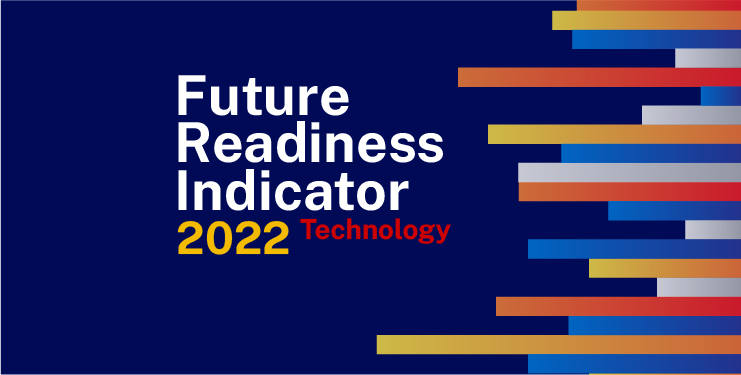IMD business school for management and leadership courses



By Howard Yu and the Center for Future Readiness
Future Readiness Indicator
By Howard Yu and the Center for Future Readiness
Technology industry future-readiness indicator 2023
From Alphabet’s slip to NVIDIA’s rise: The 2023 tech sector shuffle
In the realm of technology, future readiness is an essential metric that gauges a company’s preparedness or ability to foresee, adapt, and leverage advancements in a rapidly evolving digital environment, especially in the post-pandemic era. This concept, encompassing pandemic resilience, strategic partnerships, and profitability, is increasingly vital in assessing how organizations position themselves amidst novel technologies and automation trends emerging in 2023 and beyond.
The technology sector, like the automotive industry, is experiencing a seismic shift. Innovations such as artificial intelligence (AI), quantum computing, and advanced software solutions are redefining the landscape. These advancements are not just technological feats; they are catalysts for change in consumer behavior, business models, and market dynamics.
IMD’s Future Readiness Indicator plays a crucial role in this context. By evaluating various sectors, including technology, IMD provides a comprehensive analysis of how companies are not just responding to current trends but also preparing a roadmap for future challenges and opportunities. This indicator is a valuable tool for understanding the strategic positioning and adaptive capabilities of organizations in the face of relentless digital transformation.
What defines a future-ready tech company?
In today’s world, being “future-ready” is a pivotal concept that encapsulates an organization’s readiness to not only navigate but also excel in an ever-evolving landscape. This readiness extends beyond mere survival; it entails the capability to foresee, adjust to, and leverage emerging trends, technologies, and market dynamics.
A future-ready technology company is characterized by its proactive stance towards learning and innovation. It embraces continuous learning as a core value, encouraging its workforce to stay updated with the latest developments in the tech sphere. This commitment to learning is the cornerstone of its agility and resilience, enabling it to swiftly adapt to changes in the industry.
In addition to learning, innovation is a driving force behind future readiness. A forward-thinking tech company not only stays on top of the latest advancements but actively seeks opportunities to pioneer groundbreaking technologies. Innovation is not just a buzzword but an integral part of its DNA.
Strategic planning plays a crucial role in the journey to becoming future-ready. Such a company consistently scans the horizon for shifts in market dynamics and societal trends. This proactive approach allows it to position itself advantageously, ensuring that it can exploit emerging opportunities while minimizing potential threats.
In summary, a future-ready technology company is one that thrives by anticipating, adapting to, and capitalizing on the ever-evolving landscape of the tech industry. It embodies a culture of continuous learning, innovation, and strategic planning, positioning itself to maintain competitiveness and relevance in a rapidly changing world.
Global digital transformation rankings
Here is our 2023 ranking for global transformation in the technology industry.
Click on the company’s name for key factors that make up the score. Drag the slider to adjust the year.
Our ranking reveals interesting shifts among these tech giants. Alphabet saw a slight dip in its position, falling from second to fourth, while NVIDIA edged upward, securing the second spot from its previous third. Amazon experienced a more pronounced drop, descending from sixth to 10th place. By contrast, Apple displayed remarkable steadiness, holding firm at fifth place, and Meta also maintained its ground, keeping a steady hold on the fourth position for another year. Alibaba, however, faced a significant setback, tumbling from 16th down to 24th. Despite the increasing competition in the streaming sector, Netflix managed to sustain its rank at 12, and Tencent maintained its position at 11, showing resilience in the gaming industry.
Digital technologies have become central to the strategies of business leaders and decision-makers worldwide. Microsoft, NVIDIA, and Meta are at the forefront of this technological revolution. Each of these companies has distinguished itself through innovative contributions, setting new standards in the tech industry and reshaping our digital experiences in the following ways.
Microsoft
Under the visionary leadership of Satya Nadella, Microsoft continues to define the epitome of innovation and future readiness in the technology sector. Retaining its prime position in the Global Tech Future Readiness Index, Microsoft’s journey is marked by continuous innovation, especially in cloud computing and artificial intelligence technologies.
Despite fierce competition and rapid technological changes, Microsoft has showcased exceptional adaptability. This is evident in its expanding Azure cloud services and growing presence in the AI domain, affirming its capacity to evolve and excel in a fast-paced tech landscape.
Microsoft’s strategic moves, such as significant investments in quantum computing, further highlight its commitment to pioneering future technologies. Its approach to addressing complex challenges through cutting-edge solutions not only cements Microsoft’s position as an industry leader but also demonstrates its dedication to driving technological advancement and customer-centric innovation.
These achievements reflect Microsoft’s robust strategy and its unwavering focus on pushing the boundaries of what technology can achieve, catering to both enterprise and consumer markets globally.
NVIDIA
NVIDIA, led by Jensen Huang, has risen impressively to the second spot in the Global Tech Future Readiness Index, underscoring its pivotal role in reshaping the technology landscape.
This remarkable growth is largely attributed to NVIDIA’s breakthroughs in GPU technology and deep learning, which have revolutionized various sectors, from gaming to AI research. As a dominant force in the graphics market, NVIDIA’s innovations reflect a keen understanding of the evolving needs of both the tech industry and its consumers.
NVIDIA’s strategy of integrating GPU hardware with advanced AI algorithms sets it apart in an era increasingly reliant on high-performance computing. This integration not only guarantees cutting-edge products but also enables NVIDIA to lead in areas like autonomous vehicles and health care AI.
NVIDIA’s vision for a future powered by AI and high-performance computing is not just transformative but also indicative of its ability to anticipate and shape technology trends, solidifying its status as a forward-thinking and influential tech company.
Meta
Meta, formerly known as Facebook, has successfully secured its position by focusing on new products that enhance the digital customer experience, reflecting its strategic shift toward building immersive digital experiences.
The company’s focus on developing the metaverse represents a significant leap toward redefining digital interaction and virtual reality. This pivot aligns Meta with emerging trends in digital communication, showing its commitment to not only adapting to but also shaping future digital landscapes.
Meta’s investments in VR and AR technologies are not just about diversifying its portfolio but are also a testament to its vision of a more interconnected and technologically advanced world. By championing these new frontiers, Meta is not only reinforcing its role as a key player in the tech industry and future-ready companies but also showcasing its innovative spirit and commitment to exploring uncharted digital realms.
The company’s initiatives in these areas indicate a dynamic and forward-thinking approach to technology, positioning Meta as a pivotal architect of future digital ecosystems.
What is the future of the technology industry?
Looking ahead to 2024, the most obvious trend that tech companies must lean into is generative AI. However, it is clear that it goes beyond chatbots, despite the disproportionate attention that has been paid to OpenAI – especially with the recent ousting (and subsequent return) of its CEO, to the surprise of Microsoft. There’s more to the story of what’s to come.
1. Democratization of generative AI
McKinsey reports that AI adoption, a fundamental component of digital business, has more than doubled since 2017, with companies leveraging it for improved decision-making. Their study shows that in 2017, 20% of respondents reported adopting AI in at least one business area, while in 2022, this figure reached 50%.
The rise of open-source AI solutions and the reduction in cost and complexity have made AI accessible beyond large enterprises. Companies like OpenAI, Google, Microsoft, and Meta are at the forefront of this trend, exploring applications such as natural-language processing, which could revolutionize areas like customer service, marketing, and data analysis.
But no one shines brighter riding on the surge of AI than NVIDIA. Its advanced GPU (Graphics Processing Unit) technology – exceptionally well-suited for handling parallel processing tasks – has become the hottest commodity for AI and machine learning applications. But NVIDIA also excels in scaling new business models at extreme speed.
CUDA, which stands for Compute Unified Device Architecture, is a parallel computing platform and application programming interface (API) model created by NVIDIA. It allows software developers to use a CUDA-enabled graphics processing unit (GPU) for general-purpose processing. That’s how NVIDIA ventured into different fields. The company supports computational biology in pharmaceuticals, aids autonomous driving with machine learning in the automotive sector, provides video and image processing for movie studios, and enhances gaming with real-time simulation and rendering.
NVIDIA is also scaling up an open platform designed for virtual collaboration and real-time physically accurate simulation. This platform, called Omniverse, allows multiple users to collaborate in a shared virtual space. For example, it leverages NVIDIA’s AI technology to let architects create, visualize, and simulate building designs in realistic and collaborative virtual environments. Or, engineers can design and simulate vehicles, including testing them in virtual environments for safety and performance. But critically, Omniverse pursues an open strategy that incorporates popular 3D design tools like Autodesk Maya, Adobe Photoshop, and Unreal Engine to integrate various 3D applications.
2. Simplification of software solutions
NVIDIA aims to simplify customers’ operations by integrating multiple functionalities into single software solutions. In this regard, Microsoft is the king of software integration. Its competitive advantage lies in its all-encompassing approach. Think about Microsoft Teams. It thrives because it integrates contacts, conversations, phone calls, access to files, third-party applications, and more in a manner that “just works.” Microsoft excels, where companies like Slack or Zoom, which focused primarily on a superior chat or conference experience, fell short.
That’s why Microsoft 365 is geared toward a cloud-first experience, including familiar applications like Word, Excel, PowerPoint, and Outlook, as well as newer tools for creation and expression, all built on Microsoft Graph. Again, the Graph acts as an API that connects various Microsoft cloud services, like Office 365, Enterprise Mobility and Security (EMS), and Windows 11. Essentially, it allows developers to access and interact with a wealth of data across Microsoft’s services. It interconnects various elements like people, their relationships, work artifacts, meetings, events, and documents, creating an integrated system.
This bundling of multiple functionalities into a single, integrated solution used to be the strong suit of AWS by Amazon. But Microsoft, once a latecomer into cloud computing services, has moved up the value chain. They’re increasingly focused on additional value-added services adopting a very open approach (even more so than NVIDIA’s), and simplifying the integration and management of multiple software platforms.
3. Quantum computing applications
One wild card in the coming years is Quantum computing. It uses qubits instead of binary code, potentially solving complex calculations in minutes that would take traditional computers millions of years. Investments in quantum computing reached $35.5 billion in 2022. Companies like IBM and Alphabet are leading the way, with IBM aiming to develop a 4,000-qubit computer by 2025 and Alphabet operating a standalone quantum computing division, Sandbox AQ.
But then again, quantum computing is a moonshot. AI and software simplification are the near-term obstacles and opportunities. You can’t keep plugging money without first generating a near-term financial return to fund your long-term investment. This is why our 2023 technology rankings stand as they are.











